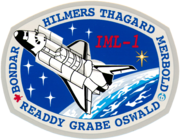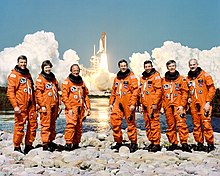STS-42
 Spacelab Module LM2 inDiscovery's payload bay, serving as theInternational Microgravity Laboratory(IML). | |
| Names | Space Transportation System-42 |
|---|---|
| Mission type | International Microgravity Laboratory-1 |
| Operator | NASA |
| COSPAR ID | 1992-002A |
| SATCATno. | 21846 |
| Mission duration | 8 days, 1 hour, 14 minutes, 44 seconds |
| Distance travelled | 4,701,140 km (2,921,150 mi) |
| Orbits completed | 129 |
| Spacecraft properties | |
| Spacecraft | Space ShuttleDiscovery |
| Launch mass | 110,400 kg (243,400 lb) |
| Landing mass | 98,924 kg (218,090 lb)[1] |
| Payload mass | 13,066 kg (28,806 lb) |
| Crew | |
| Crew size | 7 |
| Members | |
| Start of mission | |
| Launch date | January 22, 1992, 14:52:33UTC(9:52:33amEDT) |
| Launch site | Kennedy,LC-39A |
| Contractor | Rockwell International |
| End of mission | |
| Landing date | January 30, 1992, 16:07:17UTC (8:07:17amPDT) |
| Landing site | Edwards,Runway22 |
| Orbital parameters | |
| Reference system | Geocentric orbit |
| Regime | Low Earth orbit |
| Perigee altitude | 291 km (181 mi) |
| Apogee altitude | 307 km (191 mi) |
| Inclination | 57.00° |
| Period | 90.50 minutes |
 STS-42 mission patch  From left:Oswald,Bondar,Thagard,Grabe,Hilmers,MerboldandReaddy | |
STS-42was aNASASpace ShuttleDiscoverymission with theSpacelabmodule. Liftoff was originally scheduled for 8:45EST(13:45UTC) on January 22, 1992, but the launch was delayed due to weather constraints.Discoverysuccessfully lifted off an hour later at 9:52:33 EST (14:52:33 UTC).[1]The main goal of the mission was to study the effects ofmicrogravityon a variety oforganisms.The shuttle landed at 8:07:17PST(16:07:17 UTC) on January 30, 1992, on Runway 22,Edwards Air Force Base,California.[1]STS-42 was the first of two flights in 1992 ofDiscovery,the second of which occurred duringSTS-53,which launched on December 2, 1992. The mission was also the last mission of the Space ShuttleDiscoveryto have a seven-member crew untilSTS-82,which was launched on February 11, 1997.
Crew
[edit]| Position | Astronaut | |
|---|---|---|
| Commander | Third spaceflight | |
| Pilot | First spaceflight | |
| Mission Specialist 1 | Fourth spaceflight | |
| Mission Specialist 2 Flight Engineer |
First spaceflight | |
| Mission Specialist 3 | Fourth and last spaceflight | |
| Payload Specialist 1 | Only spaceflight | |
| Payload Specialist 2 | Second spaceflight | |
The astronauts were divided into a red team and a blue team to allow around-the-clock monitoring of experiments.[2]
The crew of STS-42 included the first non-American astronauts on a shuttle mission since theChallengerdisaster,Ulf D. MerboldandRoberta Bondar.Merbold wasWest Germanyfirst astronaut and was making his second flight on the shuttle. Bondar wasCanada's first female astronaut.
Mary L. Cleavewas originally selected to fly as Mission Specialist 3 for this mission but withdrew herself for personal reasons. She was replaced byManley Lanier "Sonny" Carter Jr.,who died seven months prior to the launch in a plane crash. David Hilmers was then chosen to replace him.
Crew seat assignments
[edit]| Seat[3] | Launch | Landing |  Seats 1–4 are on the flight deck. Seats 5–7 are on the mid-deck. |
|---|---|---|---|
| 1 | Grabe | ||
| 2 | Oswald | ||
| 3 | Thagard | Hilmers | |
| 4 | Readdy | ||
| 5 | Hilmers | Thagard | |
| 6 | Bondar | ||
| 7 | Merbold | ||
Mission highlights
[edit]
STS-42 was launched on January 22, 1992, 9:52:33 a.m.EST.The launch was delayed by one hour due to weather constraints. The launch weight was 243,396 lb (110,403 kg).
Discoverycarried into orbit theInternational Microgravity Laboratory-1(IML-1), a pressurized crewedSpacelabmodule, to explore in depth the complex effects ofweightlessnessonliving organismsand materials processing. The international crew, divided into Red and Blue teams, conducted experiments on the human nervous system's adaptation to low gravity and the effects ofmicrogravityon other life forms such asshrimpeggs,lentilseedlings,fruit flyeggs andbacteria.Low gravity materials processing experiments includedcrystal growthfrom a variety of substances such asenzymes,mercury,iodineand avirus.Otherpayloadsincluded 10Get Away Special(GAS) canisters, a number of middeck payloads, two Shuttle Student Involvement Program (SSIP) experiments, and anAustraliandevelopedultraviolet telescopeEndeavour.[4]Middeck payloads included Gelation of SOLS: Applied Microgravity Research (GOSAMR), Investigations intoPolymer MembraneProcessing (IPMP) and the Radiation Monitoring Experiment (RME-III).
The mission landed on January 30, 1992, 8:07:17 a.m.PST,Runway 22,Edwards Air Force Base,California,after being extended by a day for continued scientific experimentation. The rollout distance was 9,811 ft (2,990 m). The orbiter returned toKennedy Space Centeron February 16, 1992. The landing weight was 218,016 lb (98,890 kg).
Mission insignia
[edit]The four stars in the lower blue field and two stars in the upper blue field of the insignia symbolize the flight's numerical designation in the Space Transportation System's mission sequence. The single gold star above the horizon on the right is in honor ofastronautManley Lanier "Sonny" Carter Jr.,who was killed in the crash ofAtlantic Southeast Airlines Flight 2311inBrunswick, Georgiawhile on a commercial airplane traveling for NASA. Carter was originally assigned as a mission specialist on STS-42 at the time of his death.
See also
[edit]- List of human spaceflights
- List of Space Shuttle missions
- Destiny in Space,1994 documentary primarily focused on STS-42
- Nikon NASA F4
- Outline of space science
- Space Shuttle
References
[edit]- ^abc"STS-42"(PDF).NASA. September 2011.RetrievedFebruary 8,2022.
 This article incorporates text from this source, which is in thepublic domain.
This article incorporates text from this source, which is in thepublic domain.
- ^Evans, Ben (January 14, 2017)."'Traumatic Decisions': 25 Years Since STS-42 Inaugurated International Space Year (Part 1) ".AmericaSpace.RetrievedJuly 31,2024.
- ^"STS-42".Spacefacts.RetrievedFebruary 26,2014.
- ^"Endeavour".sworld.com.au.RetrievedJuly 22,2019.
External links
[edit]- NASA mission summaryArchivedMarch 4, 2016, at theWayback Machine
- STS-42 Press KitArchivedMarch 9, 2012, at theWayback Machine
- STS-42 Video HighlightsArchivedJuly 12, 2012, at theWayback Machine

